Basketboard
Basketball, as a sport, is full of "yin-yangs".
Bigger players move slower, yet they can better block others’ way by their size advantage. Smaller players tend to get obstructed by bigger ones, but they move faster.
All players have higher shooting percentage near the basket, yet it's always crowded there. And attempting to shoot far from the basket is easier (with more open space), but it always comes with lower percentage for made shots.
So here I present a simplified version of "Basketboard" by applying those "yin-yans".
Other Info:
Bigger players move slower, yet they can better block others’ way by their size advantage. Smaller players tend to get obstructed by bigger ones, but they move faster.
All players have higher shooting percentage near the basket, yet it's always crowded there. And attempting to shoot far from the basket is easier (with more open space), but it always comes with lower percentage for made shots.
So here I present a simplified version of "Basketboard" by applying those "yin-yans".
Other Info:
- Project year: 2008
Objective
To score as many points as possible in a predetermined time period.
Players and the Pieces
- A game for 2 players.
- Each player controls a team of 3 pieces. Each player take turns to control her/his team. In one turn a player can choose to move a piece or the ball.
- Each turn has a time limit (e.g. 10 sec).
- A team consists of a combination of Guards and Centers. A player can put any number of Guards or Centers as long as one team has 3 pieces in total.
(Since this is a simplified version, only 2 kinds of pieces are available: Guard and Center. For further development, Forwards could be introduced, whose attributes are pretty much in between those of Guard's and Center's.)
Rules I: Movement (per turn)
Guards (G) have better agility. In one turn they can move for 1 to up 3 grids in any directions:
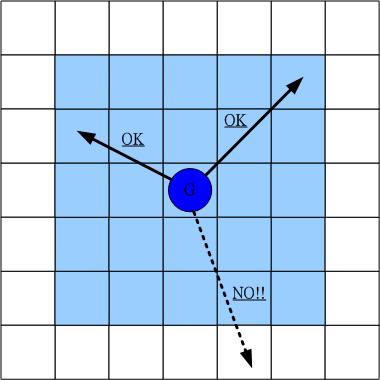
Centers (C) are slower. In one turn they can only move for one grid (in any directions):
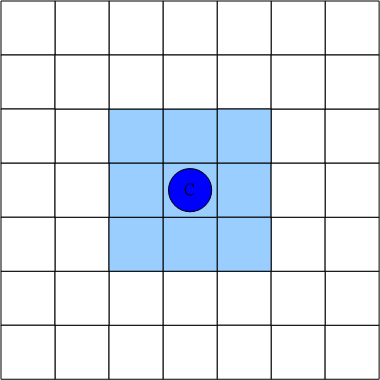
Rules II: Obstructing
For Centers, they are big in size. So wherever they stand, they have more advantage in affecting other pieces' move (both the pieces on the same and the opposing team). Any grid in the orange area is thought to be in a Center's "zone"----no passing or moving is allowed across this zone for both teams. (Using this idea, the play of "pick n' roll" can be realized in this board game by having big guys creating space for smaller teammates.)
As for Guards, since they are smaller, I set their obstruction ability to be zero.
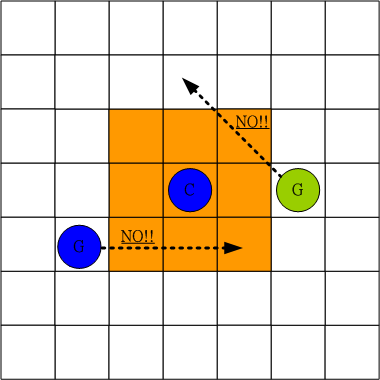
Rules III: Passing (per turn)
For both Guards and Centers, their passing abilities are the same. They can pass in the range like this (1 to 3 grids in any direction):
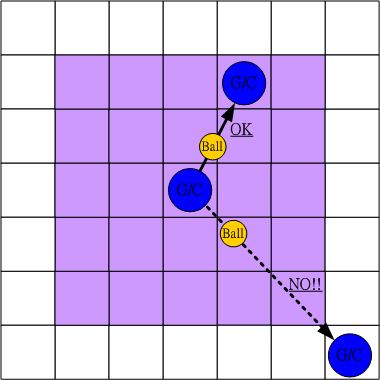
Rules IV: Shooting (per turn)
Now here comes the fun part: attacking the basket. Each player gets to shoot the ball if any of her/his pieces with the ball is in the "Shoot Zone I or O (Inside or Outside)". Since shooting is related to both probability and capability, the use of one die is introduced here. Player tosses the die once if she/he wants and is eligible to shoot.
If the shooting piece is in "Shoot Zone I" (closer to basket), he gets 2 points if the outcome of the die-tossing is anything from 1~4 (probability: 0.666). If the shooting piece is in "Shoot Zone O" (farther from basket), he gets 2 points if the outcome of the die-tossing is 5 or 6 (probability: 0.333).
And of course, if a player moves a piece with the ball to the basket (the X spot), he gets 2 points automatically without tossing the die (just like doing a lay-up shot, which usually results in a made basket).
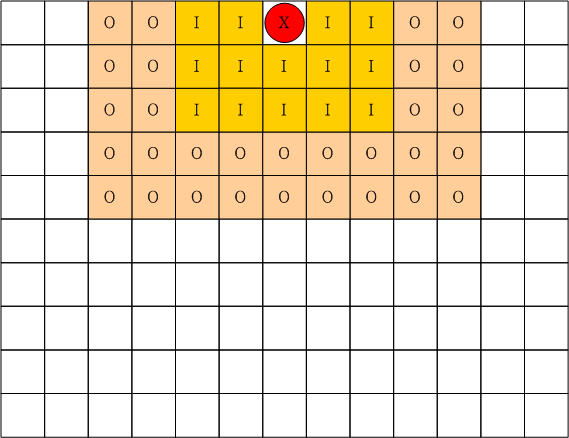
Illustrating the Lineup
The player is actually like a coach. In this version she/he can put 3 Centers at the same time to consolidate defense, or he can put 3 Guards simultaneously to move fast and carry out attacks from outside. And of course, it makes sense to put a combination of Guards and Centers together.
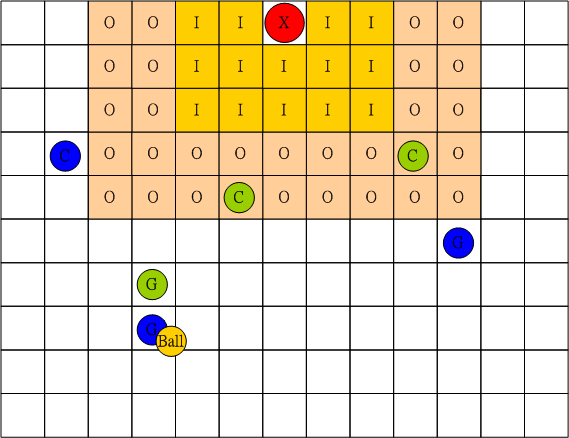
I got asked with "why do you make a board game out of basketball when you can actually play the fast-paced sport on real-life courts or within video games?" I thought, "What if I can make a board game so people can play basketball in a totally different setting? i.e., like playing chess games.” After I finished designing this game, I realized I actually had made a good educational tool for people to play a sport by thinking/analyzing/strategizing about the sport. And of course, making a chess-like board game is always a good effort before it gets possibly digitized with programming.
- Jack Chang
game design and visualization
- Special thanks to
Thom Gillespie
